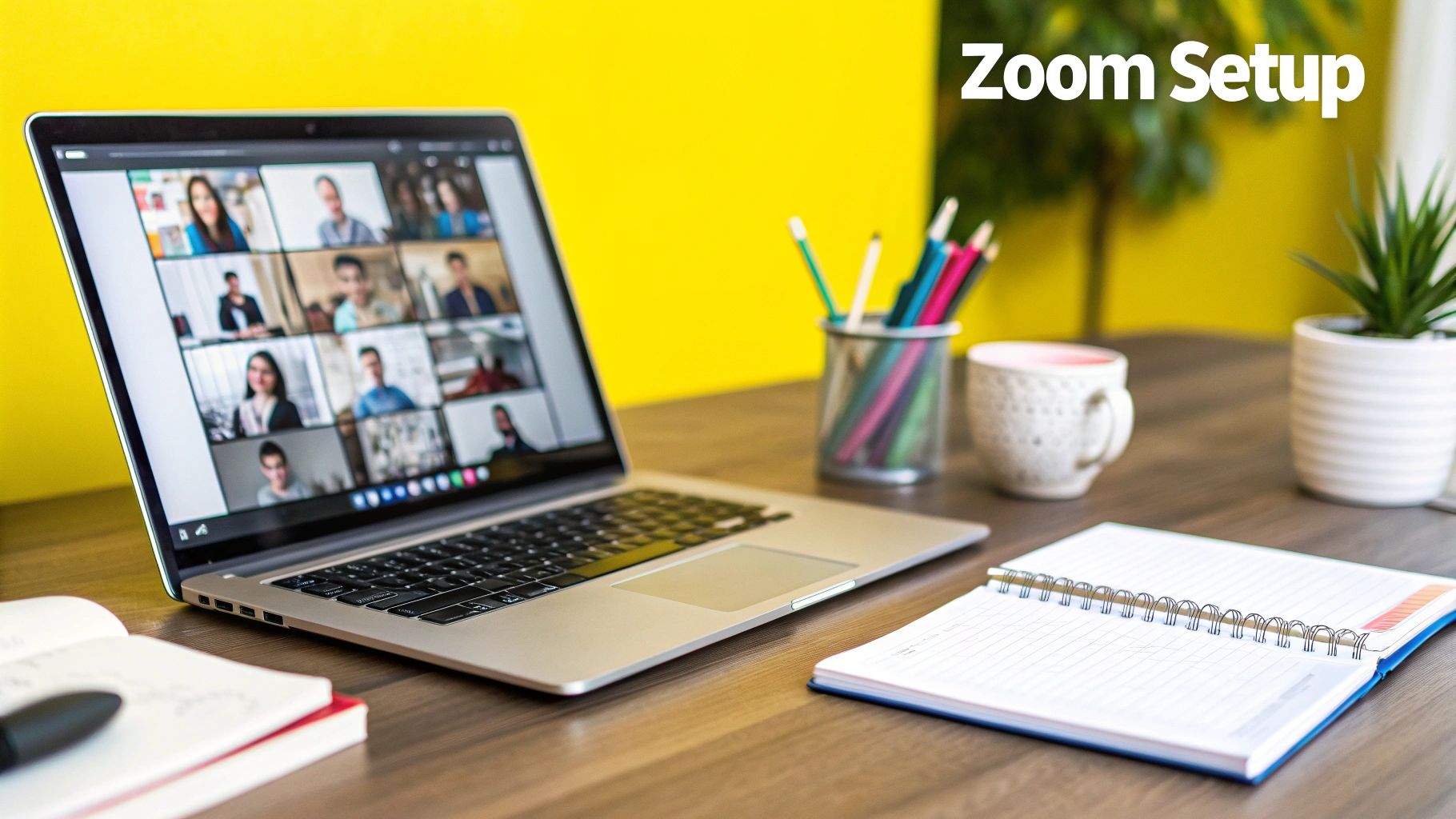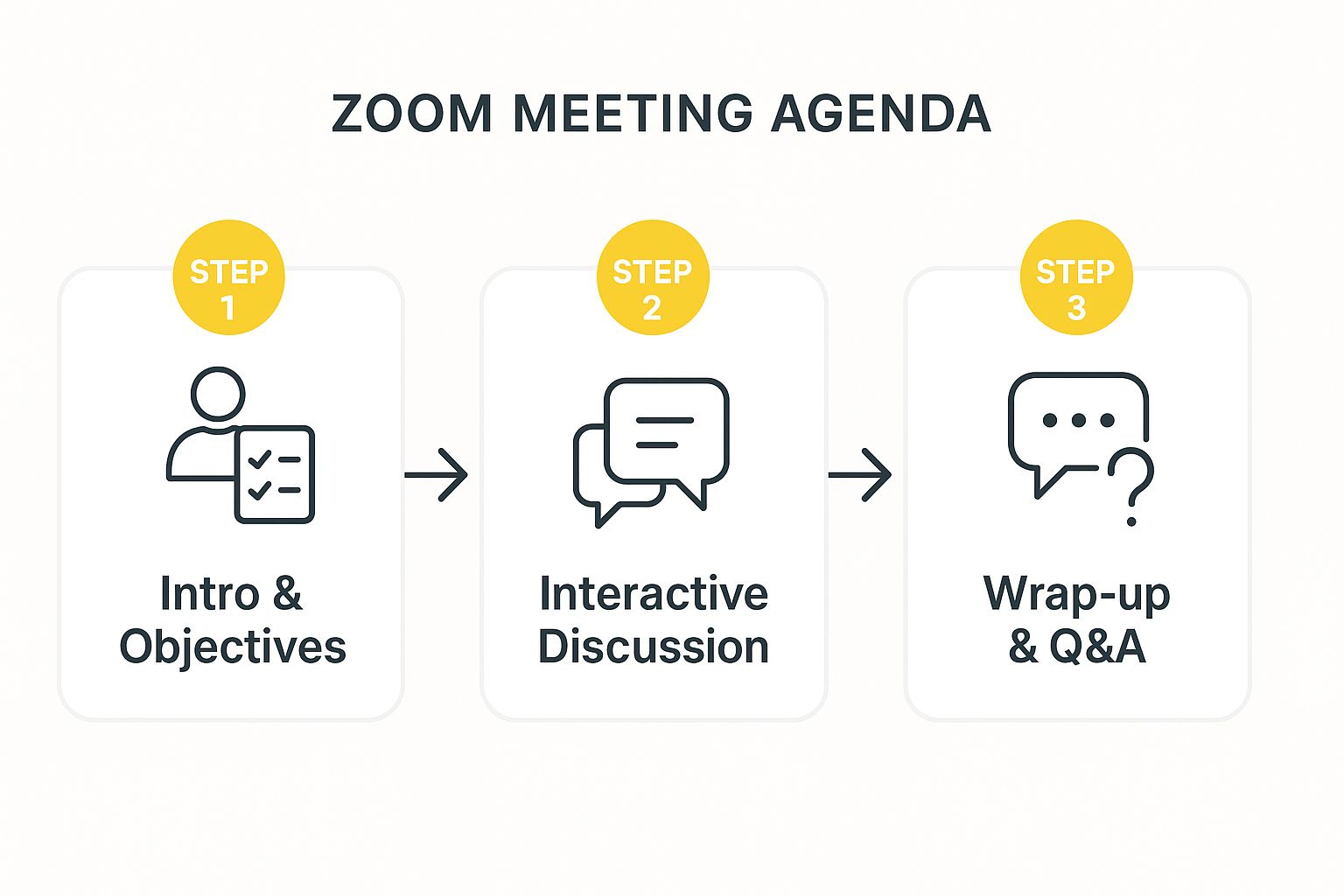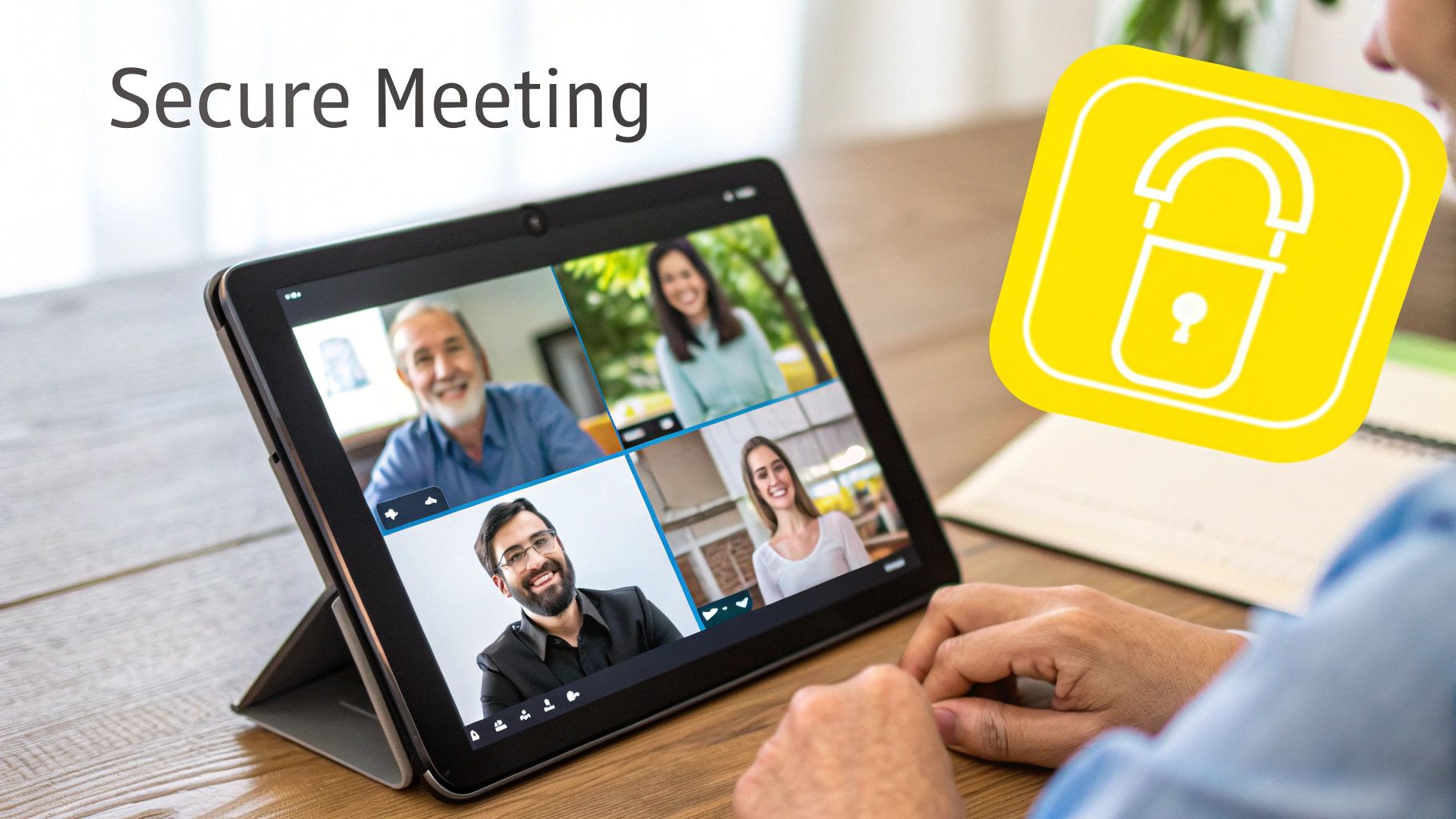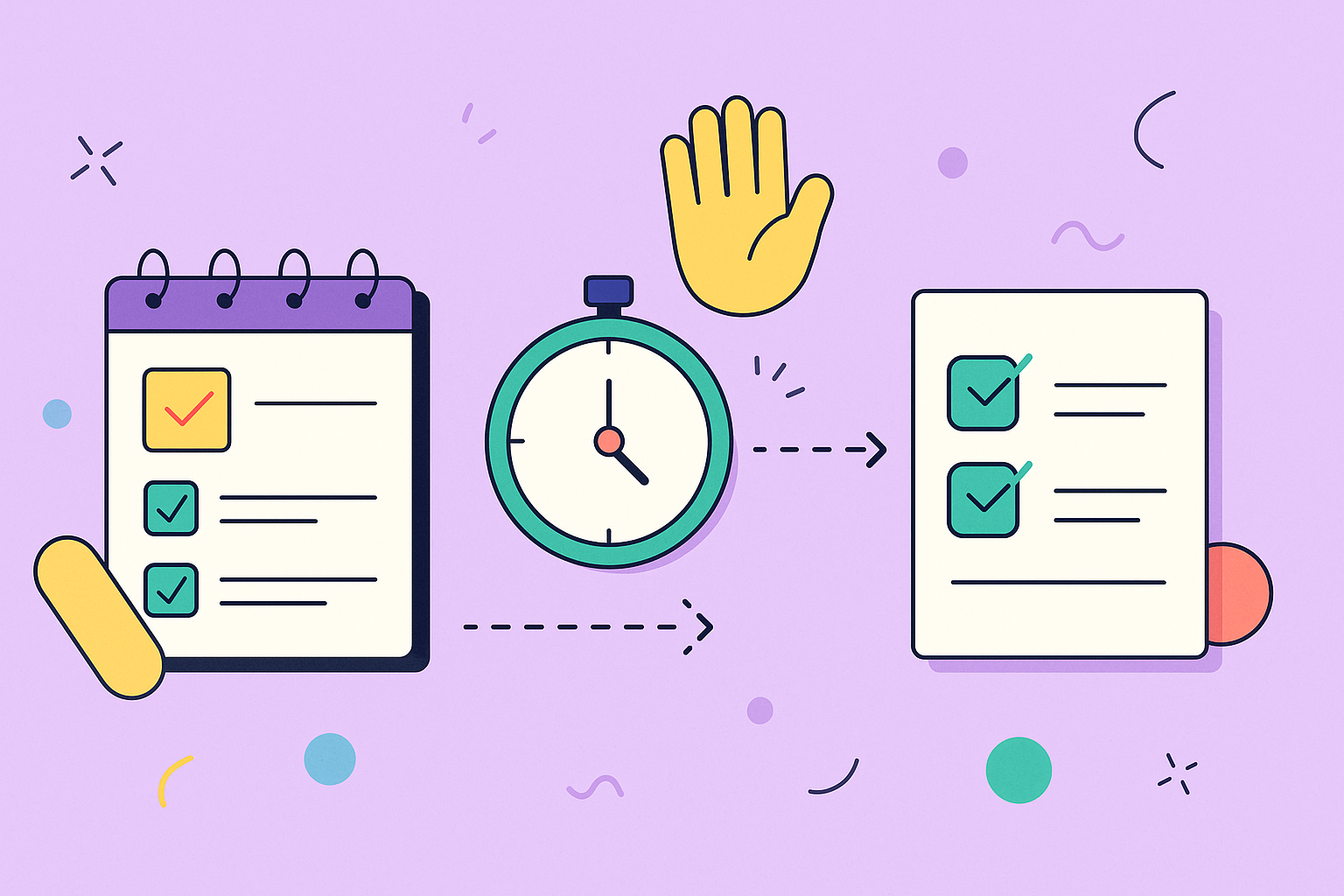Let’s be honest: virtual meetings are a core part of how we work now, but so many of them feel draining and utterly unproductive. Getting your Zoom meetings right isn’t just about sending an invite; it’s a genuine leadership skill. It’s about transforming what could be a chaotic, unfocused call into a session packed with purpose and clarity.

To make our meetings truly effective, we need a solid foundation built on clear actions and goals. Here’s a quick look at the core pillars that support a successful Zoom meeting, from start to finish.
Pillars of an Effective Zoom Meeting
| Pillar | Key Action | Primary Goal |
|---|---|---|
| Preparation | Create and share a clear agenda with defined objectives. | Ensure everyone arrives aligned and ready to contribute. |
| Execution | Actively facilitate the discussion, manage time, and encourage participation. | Maintain focus, drive toward outcomes, and keep the team engaged. |
| Follow-Up | Distribute a concise summary with action items and decisions. | Translate discussion into tangible progress and accountability. |
These pillars aren’t just a checklist; they’re a mindset. By embedding them into your meeting culture, you shift from simply hosting calls to leading productive, collaborative sessions.
Moving Beyond the Default Zoom Meeting
“Zoom meeting” has practically become a synonym for any virtual call, which speaks volumes about its massive adoption. The platform’s growth was nothing short of staggering. In December 2019, it had around 10 million daily participants. Fast forward just a few months to mid-2020, and that number had skyrocketed to over 300 million daily users.
This explosion made Zoom a household name but also shined a bright light on the common frustrations teams face. Hitting “start meeting” for every little thing often creates more problems than it solves, leading to a calendar full of calls that should have been an email.
The real challenge isn’t the technology itself, but how we use it. A poorly planned Zoom meeting can drain energy, while a well-structured one can accelerate progress and build team cohesion, even across continents.
Getting this right means we have to move past the “click and join” autopilot. We need to start treating every meeting as a strategic opportunity to get things done.
Common Meeting Pain Points
If you’ve ever sat through a dreadful virtual meeting, these issues will probably sound familiar. Pinpointing them is the first step to fixing them and running more effective virtual meetings.
So, what are the usual suspects?
- Zoom Fatigue: That feeling of mental exhaustion after back-to-back video calls. Staring at a screen and trying to process non-verbal cues for hours is genuinely tiring.
- Disengaged Participants: You know the scene—silent attendees, cameras off, probably multitasking. They’re present but not participating.
- Unclear Outcomes: The call ends, and everyone logs off wondering, “So… what did we actually decide?” No clear next steps means no progress.
- Lack of Purpose: The meeting was called without a clear agenda or goal, so the conversation just wanders aimlessly from one topic to another.
These problems aren’t just an unavoidable part of remote work; they’re symptoms of a broken process. As remote working flexibility becomes standard, optimizing how we collaborate virtually is non-negotiable. By tackling these pain points head-on, you can turn your meetings from a necessary evil into one of your team’s most powerful tools for making real progress.
Designing Your Meeting for Success
A successful Zoom meeting is won or lost long before anyone clicks “Join.” I’ve seen it time and time again: the most productive virtual sessions come from intentional design, not just blindly sending a calendar invite and hoping for the best. This pre-meeting phase is where you set the stage for everything that follows.
It all starts with defining a crystal-clear objective. What, specifically, needs to be accomplished by the time the call ends? Without a precise goal, the meeting will inevitably drift. A vague objective like “Discuss the new feature” is a recipe for a rambling conversation. A much better, more actionable goal is “Decide on the top three priority user stories for the next sprint.” See the difference?
Crafting a Purpose-Driven Agenda
Once your objective is locked in, you need an agenda that actively drives you toward it. A great agenda isn’t just a list of topics; it’s a roadmap for the conversation. You should allocate specific time blocks for each item, but more importantly, define the purpose of each segment. Is it for a decision, for feedback, or just for awareness?
Think about these two common scenarios:
- Client Kickoff Meeting: The agenda here is all about building confidence. You’d start with introductions, move to a project overview that echoes their goals, and then clearly outline the communication plan and next steps. The entire focus is on alignment and building that crucial relationship.
- Internal Brainstorm Session: This agenda needs to spark creativity, not shut it down. You might kick things off with a quick review of the problem, then jump into a timed, open-floor brainstorming session using a virtual whiteboard. From there, you’d group the ideas and vote on the most promising concepts.
The visual below shows a simple but powerful flow for structuring almost any meeting to keep the focus and momentum going.

This structure ensures you start with clarity, move into productive collaboration, and wrap up with concrete, actionable takeaways.
Choosing Participants and Respecting Time
Who you invite is just as critical as what you discuss. One of the most common mistakes I see is inviting way too many people, which absolutely kills participation. Look at your objective and invite only the people who are essential for making a decision or providing critical input. If someone just needs to be kept in the loop, a recording or a summary after the meeting is far more respectful of their time.
A smaller, more focused group of attendees almost always leads to a more engaged and decisive Zoom meeting. Every additional person who isn’t a core contributor just adds complexity and waters down individual accountability.
Scheduling plays a huge role, too. If you’re working with teams across different time zones, be considerate. Don’t be the person who schedules a call that forces a colleague to join at 6 AM or 10 PM. Also, try to build in breaks between meetings. Research has shown that even a few minutes of breathing room between calls can significantly cut down on stress and boost focus.
Finally, don’t underestimate your physical workspace. A cluttered or distracting environment can easily pull your attention away from the discussion. It’s worth exploring some practical home office design ideas for productivity to create a space that helps you stay engaged. A well-designed setup minimizes distractions and supports the deep focus you need for high-value virtual collaboration.
Kicking Off an Engaging and Productive Session
Alright, this is where all your prep work really starts to shine. The second you hit “Start Meeting” on Zoom, your role shifts from planner to facilitator. Now, your job is to guide the energy and conversation, making sure the session is productive, engaging, and most importantly, stays on track.

Those first few minutes are everything. They set the tone for the entire meeting. I always recommend starting with a bit of energy, quickly restating the meeting’s goal, and giving a brief rundown of the agenda. It’s a simple move, but it immediately reminds everyone why they’re there and shows you respect their time. This small step does wonders for focusing the room.
Getting People to Actually Collaborate
Let’s be honest: passive listening is the kryptonite of virtual meetings. To get genuine collaboration, you have to be intentional about using Zoom’s interactive tools. This isn’t about using features just because they exist; it’s about picking the right tool for the right moment to spark a real conversation.
A well-timed poll can be a game-changer. Instead of a vague, “Any thoughts on this new design?” which often leads to silence, try launching a quick poll: “Which of these three design concepts do you prefer?” You get instant, measurable feedback and give everyone—not just the loudest person in the room—a chance to weigh in.
For the more complex stuff, Breakout Rooms are your best friend. Picture this: you’re staring down a tricky bug with a team of eight. Instead of a messy, all-hands-on-deck discussion where people talk over each other, split them into two smaller groups. Give each group a breakout room for ten minutes to hash out solutions. When you bring them back together, they’ll have concrete ideas to share. It’s a fantastic way to generate more diverse solutions and empower every single person to contribute.
Making Sure Everyone’s Voice Is Heard
In any group, some people are just naturally more talkative. As the facilitator, it’s up to you to create an environment where everyone feels comfortable speaking up. This takes a gentle but firm approach.
If you notice someone is dominating the conversation, you can politely jump in. Something like, “That’s a great point, Alex. I’d love to hear what Maria thinks about that, since she has experience in this area,” works perfectly. You’re validating the speaker while smoothly passing the torch.
On the flip side, you need to actively pull quieter folks into the discussion. A simple, “Sam, we haven’t heard from you yet—what are your initial thoughts on this?” can make all the difference. Remember that silence isn’t always disengagement; sometimes people just need a direct invitation to share their thoughts.
The goal of facilitation isn’t to control the conversation, but to balance it. An effective facilitator ensures that the flow of ideas is a collaborative exchange, not a monologue.
If you’re hunting for new ways to get your team involved, you can find tons of great meeting engagement ideas that are easy to adapt for any virtual setting.
Using Visuals to Make Ideas Tangible
Abstract ideas can get lost in translation over a video call. This is where visual aids are no longer a “nice-to-have” but an absolute necessity for clarity. Screen sharing is more than just showing your desktop; it’s about deliberately guiding your team’s focus.
When you share a document, use your cursor or Zoom’s annotation tools to physically point to what you’re talking about. For anything collaborative, the virtual whiteboard is incredibly powerful. Instead of just talking about a new workflow, draw it out in real-time with boxes and arrows. This lets the team literally see the process come to life and add their own notes, turning a passive meeting into a co-creation session where complex ideas become concrete and easy to grasp.
Using Advanced Features for Maximum Impact
Once you’ve got the fundamentals of facilitation down, it’s time to start exploring the powerful, often-underused features that can turn a standard Zoom meeting into a genuine high-impact working session. These tools aren’t just bells and whistles; they’re built to solve specific collaboration roadblocks and help your team get better results.
A perfect example is Breakout Rooms. Instead of a sprawling discussion with ten people all trying to talk at once, you can split the group into smaller, more focused teams. This is a game-changer for agile problem-solving or brainstorming, especially when you need to generate multiple solutions quickly.
Each small group can dive deep into an issue without distraction, then regroup in the main session to share their findings. As a facilitator, this is where the real magic happens. You can synthesize the ideas from each room, spot common themes, and guide the entire group toward a unified decision. This approach doesn’t just increase participation—it leads to far more robust solutions.
Supercharge Your Workflow with AI and Automation
Let’s be honest: post-meeting admin is a notorious time-sink. Trying to remember who said what, the key takeaways, and who’s responsible for the next steps is a challenge. This is where Zoom’s AI Companion becomes your best friend. It can automatically generate smart summaries that highlight the most important parts of the conversation.
This automation frees up a ton of mental bandwidth. Everyone can stay present and contribute to the discussion instead of frantically typing notes. The AI can even help identify and assign action items, ensuring decisions made on the call actually translate into work. This continuous innovation is a key reason for the platform’s financial success; Zoom recently reported annual revenue of $4.66 billion, driven by enterprise demand for these exact efficiency-boosting features.
Manually summarizing a long, complex meeting is prone to error and bias. Using an AI-powered tool provides an objective record, capturing key decisions and action items with precision and saving you hours of administrative work.
To make sure nothing gets missed and to really unlock the full value of your virtual sessions, it’s worth exploring guides on recording and transcribing your Zoom conferences. Having a full transcript to review is invaluable for clarifying details and holding team members accountable.
Fine-Tuning Security and Interaction
Beyond the flashier features, mastering the finer points of meeting control can make a huge difference in the overall experience. For instance, taking a moment to configure your security settings before the meeting starts is non-negotiable.
Here are a few pro tips I’ve found essential for better management:
- Enable the Waiting Room: This simple step gives you complete control over who enters your meeting and when. No more unexpected interruptions.
- Manage Annotation Permissions: During a screen share, allowing participants to annotate directly on the content is fantastic for collaborative design reviews or document feedback. But you also need to know how to disable it instantly if it becomes a distraction.
- Use the Spotlight Feature: When one person is presenting, use the “Spotlight” function to make their video the primary view for everyone. It’s a simple way to help the whole group focus on the speaker.
These settings might seem small, but they are mighty. They empower you to maintain order, direct focus, and create a secure environment where your team can do their best work. Capturing these sessions is also key, and integrating those recordings into your existing workflows is the logical next step. You can learn more about streamlining your post-meeting process by exploring a Zoom recordings and Jira plugin to keep everything connected.
Turning Conversation into Action After the Call
A meeting’s true value isn’t measured by how long it was, but by what happens afterward. The follow-up is where all that talk turns into tangible progress, ensuring your Zoom meeting wasn’t just another conversation that fizzles out. This is the final, critical step that cements accountability and keeps the momentum going.

First things first: get a concise summary out quickly. Forget about sending long, dense paragraphs nobody will read. The goal here is clarity, not a full transcript. Your summary should be incredibly easy to scan, zeroing in on the essentials: the key decisions made and what needs to happen next.
A great summary really only needs two or three key parts. This simple structure ensures everyone can grasp the takeaways in seconds.
The Anatomy of an Effective Follow-Up
Your post-meeting notes have to be direct and to the point. You want a format that anyone can understand immediately, even if they had to miss the call.
A simple yet incredibly powerful template looks like this:
- Key Decisions: A bulleted list of the main conclusions reached during the call. For example, “We will proceed with Design Concept B for the new landing page.” This leaves absolutely no room for ambiguity.
- Action Items: A clear table or list that spells out who is responsible for what, along with a firm deadline. Vague tasks like “Look into the Q3 budget” become concrete action items: “Priya to finalize and share the Q3 budget draft by EOD Friday.”
- Recording/Summary Link: Always include a link to the meeting recording or the AI-generated summary. This is a lifesaver for anyone who couldn’t make it and for team members who just need to review a specific part of the discussion.
A well-structured summary acts as a contract of accountability for the entire team. It completely removes any “I thought someone else was doing that” confusion and creates a clear, documented path forward.
And don’t worry, crafting these summaries doesn’t have to be a painful manual chore. There are excellent practices and tools that can help you efficiently document meeting notes and action items, integrating them seamlessly right into your team’s existing workflow.
Fostering a Culture of Continuous Improvement
The final piece of the puzzle is building a simple, lightweight feedback loop. After all, you can’t improve what you don’t measure. After the summary goes out, it’s a great time to encourage attendees to share quick feedback on the meeting itself.
This doesn’t need to be some formal, five-page survey. A simple question dropped into your team chat like, “What’s one thing that worked well in that meeting, and one thing we could do better next time?” is often more than enough.
This small habit fosters a culture where everyone feels a sense of ownership over the quality of your virtual collaborations. It helps you pinpoint what to keep doing and what to adjust, ensuring your Zoom meeting practices get better and better over time.
Common Zoom Meeting Questions Answered
Even with the best intentions, some recurring questions always seem to pop up when teams try to get their virtual collaboration just right. If we tackle these common pain points head-on, we can seriously boost the quality of every Zoom meeting and turn potential frustrations into productive sessions.
One of the most frequent concerns I see is how to handle disruptions, especially on bigger calls. The best defense is a good offense—proactive management is your friend here. Start each meeting by setting clear expectations, like asking everyone to stay muted unless they’re speaking and to use the “Raise Hand” feature for questions. Another game-changer? Assign a co-host. They can be your second set of hands, managing the waiting room, fielding chat questions, and muting anyone with unexpected background noise.
Preventing Burnout and Boosting Collaboration
The question I probably hear more than any other is about “Zoom fatigue.” Honestly, the simplest fix is to be ruthless about whether a meeting is even necessary. If a topic can be sorted out over email or a quick chat, just cancel the meeting. For calls that absolutely must happen, keep them as short as possible with a crystal-clear agenda.
It’s also a good idea to encourage “camera off” time to give everyone a break from being constantly “on.” For longer sessions, build in short stretch breaks. People need it.
The real secret to fighting fatigue is shifting the dynamic from passive listening to active participation. A meeting where people are interacting and creating something together is way less draining than one where they’re just staring at a screen.
For teams that need to collaborate, a few built-in Zoom features are absolute gold.
- Breakout Rooms are fantastic for splitting into smaller groups for brainstorming or tackling specific problems.
- The virtual Whiteboard is a must-have for mapping out complex ideas and workflows as a team.
- Screen sharing with annotation lets you give immediate, on-the-spot feedback on documents or designs.
- Polls and Reactions are great for getting a quick pulse check or gauging consensus without derailing the whole conversation.
These tools are especially powerful when used in structured formats like Agile ceremonies. For a deeper dive into that, our article on how to run effective daily stand-up meetings has some practical tips that you can easily adapt for all sorts of team check-ins.
For teams looking to bring structure, clarity, and engagement to every meeting, resolution Reichert Network Solutions GmbH offers NASA – Not Another Standup App. Built for Jira, it helps you run highly efficient meetings with timed agendas, turn-based sharing, and transparent follow-ups, ensuring every conversation drives action. Discover how to transform your agile meetings at https://www.resolution.de/nasa.
